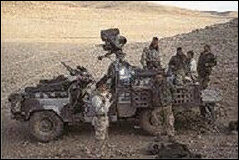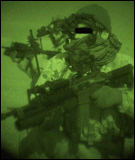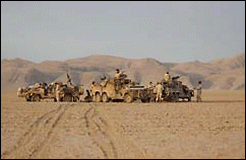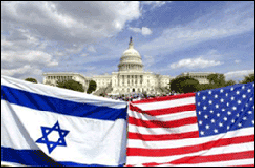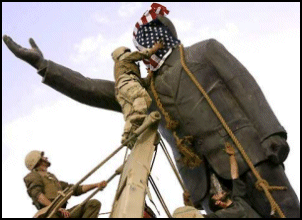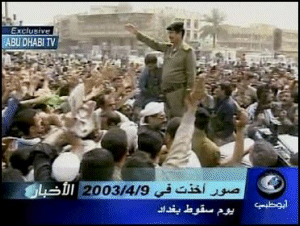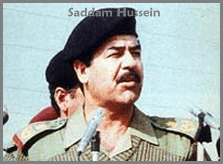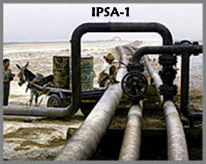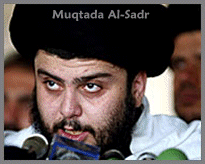
by
Joe Vialls
Part 1
January - December 2002
from
Vialls Website
recovered through
WayBackMachine website
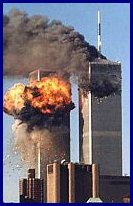
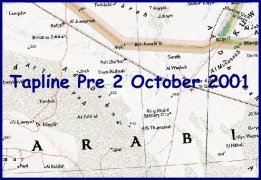
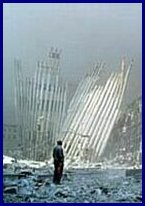
In early March 2001, a leading European
intelligence agency received disturbing news from its most senior and
trusted agent in Tel Aviv. Aware of growing international resistance to its
ruthless and murderous suppression of the Palestinians, the Israeli Cabinet
had met to discuss the limited ways in which it could proceed with its plans
to annex the rest of Palestine, with or without the support of principal
ally America, or the “International Community”.
At the time, the Israeli Cabinet had no idea
that the subject matter of its March meeting would later become one of the
prime reasons for the September attack on the World Trade Center.
The Israeli Cabinet was seriously worried. Despite effective control of the
western media by the Jewish-American lobby, risk assessment conducted in Tel
Aviv showed there was still a high probability that continued ruthless
Israeli activity in Palestine, would lead in turn to increased sanctions by
the western nations. Initially the sanctions would take the form of
decreased arms shipments to Israel, followed later by increasingly large
cuts in overseas financial “aid”, still provided in the main by unwitting
American taxpayers.
Sooner or later financial aid might dry up completely,
but this was not the worst case scenario.
Eventually, if western public opinion became strident enough, America and
Europe might feel compelled to impose a complete oil embargo on Israel. With
no natural resources of its own, and only limited strategic oil reserves in
the country, Israel’s armed forces would grind to a complete standstill in
only a few weeks. Aircraft and battle tanks have an almost insatiable thirst
for petroleum products, and when those products run out, the aircraft and
tanks are no more use to their owners than chunks of aluminum and steel
waiting for the recycling smelters.
Clearly then, the Israeli Cabinet had to find an alternate source of oil,
and find it quickly. Moreover, bearing in mind they would no longer be able
to pay for the oil because of financial sanctions, the new source would have
to be “free”. Back in the sixties, ambitious Israelis had made detailed
plans to acquire just such an alternate source of oil by force, but the
plans had to be shelved for geopolitical reasons. Those geopolitical
restrictions no longer existed in 2001, so the old plans were taken out of
storage, dusted off, and renamed Operation Shekhinah.
Stealing oil reserves from another nation is certainly not an original idea.
The closest historical precedent for Operation Shekhinah was probably
back in 1941, when Roosevelt imposed a total oil embargo on Japan during the
first American “War
on Terror”.
Seeing conflict as inevitable and recognizing
its desperate need for an alternate source of oil, the Japanese responded
accordingly, acutely aware that in order to reach and utilize the oil
reserves in the Dutch East Indies, it would first have to overwhelm the
[then] vastly superior US Navy.
It was in this context that Admiral Isoroku Yamamoto,
Commander-in-Chief of the Japanese Combined Fleet, suggested an air attack
on the US Pacific Fleet, which had moved from its usual base at San Diego on
the American west coast, to a mid-Pacific location at Pearl Harbor in May
1940. Yamamoto's plan was a development of the traditional Japanese
defensive strategy. He gambled on a surprise attack to destroy the American
naval capability in the Pacific, including its all-important aircraft
carriers, and create enough time, perhaps six months, to enable Japan to
complete its territorial conquests.
Simultaneous attacks by the Japanese army on Hong Kong, Malaya, the
Philippines, Guam and the Dutch East Indies would capture the strategically
important bases and areas rich in raw materials Japan felt was vital for its
national survival and would also now be needed to sustain its war with
America. The rest, as they say, is history.
Along much the same lines, and for similar strategic reasons in 2001, Israel
intended to launch a surprise attack against southern Iraq, capture its
southern oil fields, then use the old existing Trans Arabian Pipeline [“Tapline”],
to pump the oil back to its own refineries at Haifa. Technical details of
the operation will be provided later in this report, and in part two to
follow, but first we need to examine the chances of the operation
succeeding, and the subsequent reaction of the western nations and Russia.
Back in the sixties, when the operation was first planned by Israel, the
British, Russians and Europeans had huge investments in the middle east, so
an outraged backlash against Israel would have been immediate, and probably
terminal for any ongoing “Jewish State” in Palestine.
It was on this basis that the Iraqi plan was
shelved and left to gather dust. However, during the years that followed,
the entire geopolitical landscape changed. By March 2001, the Israeli
Cabinet considered the risks to be minimal, and probably non-existent if
Operation Shekhinah was handled correctly. What had changed the odds was the
new status of Iraq.
During the late eighties and nineties, the fledgling “New
World Order” and the media had spent millions of dollars
demonizing President
Saddam Hussein, to the point where he
was eventually regarded by 95% of the western public as “The Butcher of
Baghdad”. Not only was this Iraqi demon allegedly manufacturing weapons of
mass destruction almost identical to those stored in America, he was also
the tyrant who “gassed his own Kurds at Halabja”.
President Hussein did no such thing. In February 1990 the US Army War
College published a report titled “Iraqi Power & US Security in the Middle
East”, which proved the Kurds of Halabja died as the direct result of an
Iranian Phosgene gas attack. But the western media, firmly in the grip of
the Jewish-American lobby, wasn’t going to let the hard truth get in the way
of its frantic vilification campaign.
In light of Saddam Hussein’s new demonic status, the Israeli Cabinet
reasoned in March 2001 that no one would now object to Israel taking
strenuous action against this “known war criminal and killer of babies”.
Instead, it was calculated that the action would be seen by the western
public as daring.
Once again the brave Jews would have taken a
stand against a dictator in the sacred name of democracy; and hopefully the
western public would not notice the millions of barrels of stolen Iraqi oil
flowing back to its refineries in Haifa.
And even if they did notice, what could they do
about it with Israel already in occupation?
Before Operation Shekhinah could be launched, Israel needed its own
“tame” Arabs on the ground in both northern Saudi Arabia and southern Iraq.
Detailed plans of the area had to be drawn up or updated, and airfields and
assembly points for incoming Israeli aircraft and ground troops arranged. In
order to avoid suspicion or unwanted prying eyes, Israeli agents infiltrated
the areas and started offering certain Shi’ite Muslims in the area “free
passage” to other countries away from their enemy Saddam Hussein, plus
spending money to take with them, in exchange for their ramshackle homes in
the area.
Predictably there was no shortage of takers, and by mid April 2001 the
preliminary operation was in full swing.
Droves of Shi’ite Muslims quietly started
departing the area for America, Europe and Australasia at enormous cost to
the Israelis. Buying entire people smuggling operations was an incredibly
expensive business, to which had to be added the ad hoc payments to the
migrants and other significant expenses. Once again America unwittingly came
to the rescue, with certain financial institutions in the World Trade Center
laundering most of the massive funds needed.
This activity was conducted with alacrity, because Israel had offered a
dazzling quid pro quo to its financial juggernaut in New York City. Once
firmly established in southern Iraq, the new Israel would be at the
crossroads of middle east oil, not only with direct control of the giant
southern Iraqi fields, but also within easy striking distance of Kuwait,
northern Iran, and the northern Iraqi pipeline routes.
From this position of enormous strength, Israel would be able to either
control or blackmail the local states into marketing their oil in an
“organized way”, rather than allowing any old Tom Dick or Harry to buy the
stuff on the Rotterdam Spot Market. Using sophisticated insider trading
techniques, OPEC would be neutered, and world oil supplies would come under
the exclusive de facto control of NYMEX and the New York Stock Exchange in
the World Trade Center.
Concurrent with this activity, the Jewish-American Lobby was frantically
urging the White House and US Department of State to step up its enforcement
of the illegal “no fly” zones over northern and southern Iraq.
The records show that attacks did indeed
increase during this period, though the American and British pilots could
not have known they were being deliberately used to “blind” the Iraqi air
defenses, and ensure they stayed blinded in the run up to Israel’s Operation
Shekhinah. When the Israeli surprise attack was finally launched, there
would be not the slightest chance of detection by Baghdad until it was too
late.
The possibility of military intervention by the United States seemed to
trouble the Israeli Foreign Minister, but risk assessment came to the rescue
and calmed his fears. Though a few US military aircraft based in Kuwait
would probably have to be destroyed, either on the ground or in the air, it
was calculated that this would not be a problem in technical or public
relations terms.
Technically, the Israeli aircraft had home-grown fire control systems vastly
superior to their American equivalents, and could be relied on to shoot down
the US jets swiftly and with the minimum of fuss. In public relations terms
the Israelis would later claim it was a case of “mistaken identity”, twist a
few arms and grease a few palms in Washington, and the whole affair would be
swept under the carpet.
Once again the Israeli Cabinet had a sound
precedent for this, in the form of the USS Liberty.
On 8 June 1967, during the Six Day War between Israel and the Arab
States, the unarmed American intelligence ship USS Liberty was attacked for
75 minutes by Israeli aircraft and motor torpedo boats.
Thirty-four men died and 172 were wounded.
Despite the proven fact that the USS Liberty was far offshore in
international waters, and flying a bright, clean American flag, Israel
insisted it was all a terrible case of mistaken identity, which it most
certainly was not. Israel attacked the USS Liberty in an attempt to “blind”
the American intelligence ship and prevent it forwarding details of Israel’s
pre-emptive strikes to the Pentagon.
The Jewish-American Lobby went to work with a vengeance in Washington,
twisting arms and handing out pieces of silver. So effective was the
lobbying that the murder of thirty four American sailors on the unarmed USS
Liberty went largely unnoticed by the public, and the media was predictably
silent on the matter.
Though the Liberty’s Captain William Loren
McGonagle was later awarded the Congressional Medal of Honor for
conspicuous gallantry and intrepidity at the risk of his life above and
beyond the call of duty, it was presented to him quietly at the Washington
Navy Yard, rather than the White House as is customary.
American politicians had bent over backwards to avoid embarrassing the
murderers of the thirty-four American sailors.
The Israeli Cabinet thus knew full well that any
American “collateral damage” during Operation Shekhinah could be
swept under the carpet in exactly the same way.
By early June 2001 the trickle of Shi’ite “migrants” out of northern Saudi
and southern Iraq had swelled to a flood, which came to the attention of at
least two more European intelligence agencies. For reasons unknown but
presumably acting on orders, the Shi’ites were all woodenly claiming they
were Afghans, which was not a good move. Afghans speak Farsi but these
people couldn’t speak a word of it, which is hardly surprising. The native
language in both northern Saudi Arabia and southern Iraq is Arabic.
Around this time Russia also became aware of the pending Israeli operation,
though it is not yet known whether the information was leaked by a European
agency, or provided direct by one of its own agents in Tel Aviv.
But what was known by all by this time, was the
actual start date for Operation Shekhinah: 2 October 2001, the first day of
a seven-day Jewish holiday, and thus a most unlikely period in which expect
an attack by Israel.
Things then went very quiet for a few weeks until 12 July, when Pravda,
still considered by many as the establishment voice of Russia's old guard
communists who control the military and intelligence agencies, printed a
story on its page one entitled “Will the Dollar and America Fall Down on
August 19? That's the Opinion of Dr. Tatyana Koryagina".
Was Mother Russia using this expert, and
deliberately citing the wrong date, in order to distance herself from
involvement in the upcoming 11 September attack on the World Trade Center?
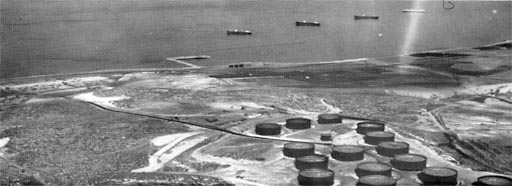
Tapline - the Sidon terminal
In order to get a true feel for the importance
of oil to Israel, it is necessary to take a stroll back through history, to
a time when the sky was continually lit by the flashes of heavy artillery
shells and exploding bombs, as nations around the globe struggled with World
War Two.
But as the two sides struggled with the other,
an entirely separate third battle was being fought behind the scenes. While
the Americans, the British and their allies fought savagely and died in
their thousands for secular democracy, others were fighting a covert
quasi-religious war.
Zionists worldwide were actively plotting to overthrow Palestine in order to
provide a “haven” for poor dispossessed Jews from around the globe,
especially those who had suffered at the hands of the Nazis in Germany.
Naturally the Zionists insisted that they had no
territorial ambitions, confirmed by Ben Gurion, who stated the
easternmost Israeli border would be “the Syrian Desert, including the
furthest edge of Transjordan.” So no real problem. Just relocate a few
thousand Palestinians to make way for the Jews, and everyone would be happy.
As historical documents show, and modern Zionists freely admit, this was
propaganda intended only for the gullible masses. The true intent of the
Zionist elite was a smash and grab raid of staggering proportions, securing
territory from the Mediterranean coast and the River Nile in the west, to
the River Euphrates in the east, together forming the new Greater Israel.
By the end of the Second World War, the “new” Israel was shaping up as the
biggest and most exciting game in town.
Control of this vast block of territory would
allow its new owners to completely dominate the crossroads of traditional
world trading routes, regulate world oil shipping routes including the Suez
Canal, and [effectively] control the Persian Gulf.
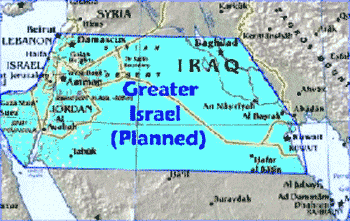
In common with all 20th Century engagements, the
battle for Greater Israel would require vast quantities of oil to drive the
machines of war: Oil which the British and Iraqis had already piped into the
port city of Haifa to serve the British naval and military bases in the
Eastern Mediterranean.
By 1946 two pipelines fed the refineries and
loading terminals at Haifa: the first a ten-inch line running direct from
Iraq to Palestine, and the second a sixteen-inch line running from Iraq to
Palestine via Jordan. Also on the drawing board that year was a new mammoth
thirty-inch line from Bahrain and Saudi Arabia to Palestine, nicknamed the “Tapline”.
Thus if the Zionists planned their attacks swiftly and efficiently, they
would be able to sweep through Palestine, Jordan, and Iraq, using the
existing refineries and pipelines to meet the needs of their war machine.
Once the territory had been conquered, the newly created Greater Israel
could and would charge the Saudi’s and Bahraini’s vast Tapline royalties,
and massive fees for the use of “its” refineries in Haifa. It was heady
stuff, but by the time the Jews had finished slashing and burning their way
though western Palestine in 1948, unwisely killing British as well as
Palestinian citizens on the way, someone somewhere had already blown the
whistle on their overall strategic ambitions.
As if by magic, the ten-inch and sixteen-inch lines oil were cut at source,
and the Arabs started to fight back. Because the Jews were not exactly the
darlings of the western world in 1948, and were strapped for both cash and
oil, they had to call a temporary halt in what was to become Israel up until
the next aggressive expansionist attempt during 1967.
But significantly, in
1948 the Zionists had established a firm “beachhead” for Greater Israel.
The need to sever the pipelines had dealt a severe blow to the Arabs, who
were now faced with transporting most of their oil out through the Persian
Gulf, a extra distance of more than 5,000 nautical miles on the way to
market. True a small pipeline still ran from Iraq through Syria to the
northern Lebanese port of Tripoli, but it carried only a tiny fraction of
the oil. So in the end the thirty-inch Trans Arabian Pipeline (Tapline) was
built, though not without significant difficulty.
Syrian parliamentary objections necessitated the
CIA-aided 1949 coup in Damascus to secure "right of way" over the Golan
Heights. Two CIA agents, one of them Miles Copeland, simply installed a
Syrian Government prepared to sign the new right of way agreement, and Tapline was re-routed around the northern tip of Israel to the southern
Lebanese port of Sidon.
The psychological impact of Tapline on the Israelis from its opening during
1950, should not be underestimated. Robbed of what they believed to be their
historical birthright, by a lack of oil to drive their war machine on to a
Greater Israel, they were now forced to watch impotently as that very oil
flowed by, tantalizingly close to their border on the Golan Heights.
On any
single day, when the wind was not blowing and the air was still, they could
hear the muted hum and swishing as nearly 500,000 barrels of sweet black
crude oil flowed straight past, on its way to Sidon and the export markets.
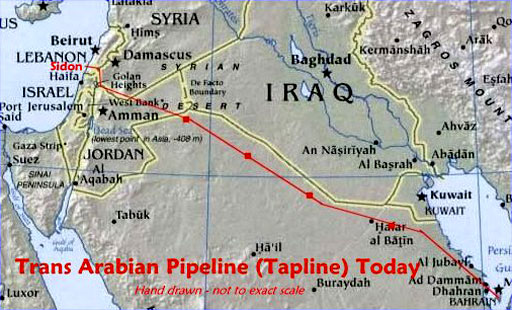
Then in 1967 the Israelis launched their “Pearl
Harbor” surprise attack on the Arab nations, blitzing the latter’s air
forces on the ground, and expanding their own territory to include the Sinai
in the south, and the extended Golan Heights in the north.
The Israeli’s
would have taken more if they thought they could get away with it, but once
again international public opinion and limited pressure from America forced
a halt. What went almost unnoticed was that for the first time since its
opening back in 1950, the Tapline now ran through the Israeli-occupied part
of the Golan Heights, rather than through Syria.
This incredibly important new strategic reality seemed to escape the
attention of everyone, including the premier American Military Academy at
West Point.
Nowadays the maps in the West Point Reference Library show lots
of interesting tidbits about Israeli advances, roads and other mundane
geographical features in and around the Golan, but not a glimpse of Tapline
(below map).
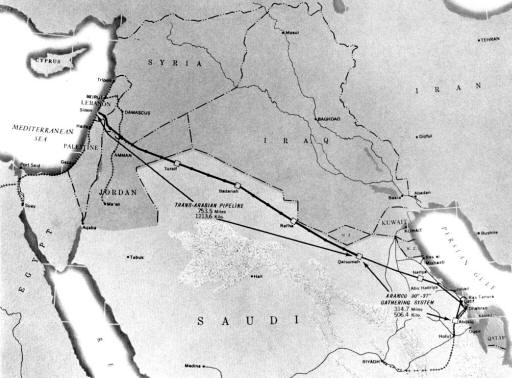
Clearly where American military strategy is concerned, a pair
of cleverly-sited Israeli machine gun nests on a hill in the Golan facing
Syria, are more important that an oil pipeline large enough to fuel Israel’s
entire army on its journey to the River Euphrates in Iraq.
Due to the failed Syrian attempt to take back the Golan Heights in 1973, and
a host of other destabilizing factors including Israeli pipeline sabotage
and problems in the Lebanon, all oil transportation in the western [Syrian
and Lebanese] portions of the line ceased in 1976.
That portion of the line
was evacuated of all crude oil and the installations in Lebanon were handed
over to the Lebanese government in 1983, after the Israeli invasion of that
country.
The western section of the Tapline was not destroyed, and currently sits
idle, still capable of transporting up to 500,000 barrels of oil per day.
Until 1991 the eastern section of the Tapline was used to supply Jordan, but
Saudi Arabia terminated this arrangement to display displeasure with
Jordanian support for Iraq during the Gulf War.
Tapline was and remains a
central feature of Israel’s strategic plans to take Greater Israel by force,
despite western objections, and despite threatened western sanctions
designed to moderate its behavior.
Much of the detailed current planning for Operation Shekhinah will be
covered in Part Two of this report, because we first need to look at new
geopolitical alliances in the area. After all, logic dictates that if the
Israelis reasoned they could use Tapline back in 1967, why did they not do
so then? The simple answer is that on top of the lethal problem of Iraq,
they would have faced fierce resistance from just about every Arab nation in
the Middle East, and from Iran.
A spectacular defeat would have been
inevitable.
But then along came the very convenient Gulf War and everything changed.
Though the demonization of Saddam Hussein is known to every western
television viewer, the more subtle aspects of Middle East politics are not.
Because they felt threatened, three Arab states in particular were forced
embrace America and American troops.
Kuwait was obviously the first because
its territory was occupied by Iraq, but was followed swiftly by Saudi Arabia
and Bahrain, who rapidly found themselves overwhelmed by thousands of
disrespectful British and American soldiers dropping empty Coco Cola cans
and other assorted trash all over the sacred religious routes to Mecca.
The soldiers were supposed to go home after the Gulf War of course, but as
we all know, the Americans and Brits like to “hang out” in their colonies
for a little while after hostilities cease, normally for about fifty years.
This quaint Anglo Saxon tradition swiftly led to tensions in the area so
great, that by the mid 1990s the two smaller partners, Kuwait and Bahrain,
were seriously worried about being left out in the cold.
If, as seemed likely, the Saudi’s were eventually obliged to remove the
American soldiers from their sovereign territory, Kuwait and Bahrain might
be forced to do the same under sustained pressure from their local
populations. Huge problem: If you send the Americans and Brits home, then
who will protect you from big bad Saddam Hussein?
Certainly not Saudi
Arabia, which has barely enough weapons to protect itself.
On hearing about this delicate problem, Israel held a series of secret talks
with senior officials from Kuwait and Bahrain during late 1997, aimed at
finding a mutually agreeable solution. It was agreed that both Emirates
would be prepared to pump oil to Israel, provided the Israelis provided a
defensive barrier between them and Iraq. Discreetly of course, because
neither Emirate could possibly allow Israelis on its own territory.
Limited tactical requirements were discussed, including the expensive
relocation of Shi’ite Muslims out of northern Saudi Arabia and southern
Iraq, a process which as we already know continued to accelerate until a few
days before the destruction of the World Trade Center in New York.
A year after the secret tripartite meetings, in what seemed at first to be
an unconnected incident, the Jordanian Government found to its horror that a
corrupt official had quietly dug up and sold more than fifty kilometers of
disused sixteen-inch oil pipeline, originally used to pump oil between Iraq
and Palestine.
It transpired that this pipe was in perfect order, and
carefully inspected as such by the mystery cash buyer. When interrogated,
the official admitted his guilt but had no idea who the end user might be.
Checks established the buyer was not Syrian, Saudi, Egyptian or Palestinian.
So who?
Now this is a difficult one. Let me see… The buyer was secretive, meaning he
did not wish to attract attention or arouse suspicion on the open market. In
order to arouse suspicion on the open market in the first place, the buyer
must have come from a country with no oil reserves of its own.
Somebody jog
my memory here: How far is it from the Golan Heights down to the refinery at
Haifa?
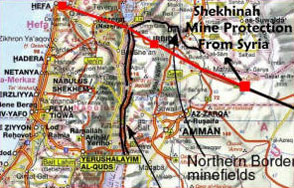
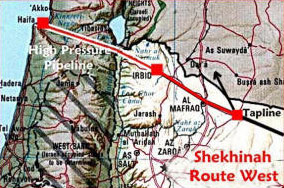
Before we start wallowing around in crude oil
and pipelines, we need to briefly revisit the
September 11 attack on the
World Trade Center.
Though it is obvious to most readers that the attack was
driven at least in part by concern over control of the Middle East, it is
not yet entirely clear whether this was the primary motivation, and if we
reasonably exclude Arabs living in Afghan caves, we do not yet have the real
villain. The coordination and precision of the attacks on New York and
Washington, point to the direct involvement of one or more first-world
government agencies. The resulting chaos was unquestionably as strategic as
it was deadly.
The global impact of Operation Shekhinah cannot be overstated. Allowing
Israel to position itself in southern Iraq, steal the oil and thereby place
itself beyond sanction, would be grossly irresponsible. Not only would the
“new” Israel directly threaten the remaining Arab States, it would
indirectly also threaten Britain, Europe, Russia, Japan and China.
We know
that information about Operation Shekhinah was received by at least some of
these countries by late March 2001, but we do not know how many. Operation Shekhinah could easily turn the global strategic balance upside down, a
reality that one or more of the countries listed above might not be prepared
to allow.
As noted earlier, the only visible peripheral clue we have to the
possibility of direct first-world involvement is the outspoken Dr. Tatyana Koryagina, who Pravda quoted on 12 July in its page-one article “Will the
Dollar and America Fall Down on August 19?”.
In fact this article was based
on an earlier meeting at the Russian Duma on 29 June, attended by leading
figures including American presidential hopeful Lyndon Larouche, a
self-styled economic “expert” who for years has advocated a complete change
in the global economic structure.
All the participants at the Duma that day, agreed America was a huge
financial pyramid due to crash soon, but some vigorously challenged Dr
Koryagina on the method, i.e. how could this be done without a war, without
missiles, or bomb strikes?
Tatyana Koryagina, known to be close to President Vladimir Putin, responded
in a cryptic manner:
“Besides bombs and missiles, there are other kinds of
weaponry, much more destructive ones”. She went on to explain further: “The
U.S. has been chosen as the object of financial attack because the financial
center of the planet is located there. The effect will be maximal. The
strike waves of economic crisis will spread over the planet instantly and
will remind us of the blast of a huge nuclear bomb.”
End quote.
The US has
been “chosen”? What an interesting Freudian choice of words, Tatyana!
Conspiracy or coincidence?
Despite the curiosity value, on balance we are
forced to settle for coincidence because we have no hard proof of guilt.
Certainly in the aftermath of 9/11 Dr Koryagina has been proved unerringly
correct, because massive economic shock waves are still spreading outwards
across the planet, five months later. But direct involvement?
To use this
minimal information to claim the Russians were directly involved in the WTC
attack, is as ridiculous as pointing the finger at Great Britain on the
flimsy grounds that British-owned Barclays Capital, was the only company
known to have closed its office in 1 WTC and moved its employees to 222
Broadway, shortly before the attack took place.
Stirring stuff, but it was all part of larger relocation plan. On 5
September 2001, Barclays plc announced it would be moving all of its staff
from the City and the West End of London, to Canary Wharf in Docklands, many
miles to the east.
Put simply, we cannot really tell from pointing fingers at different people
and different companies whether there is any tangible connection between the
WTC attack and Shekhinah. All we know for sure is that the resulting chaos
slowed the operation down drastically. Quite apart from funding the huge
bill for moving vast numbers of Shi’ite Arabs out of northern Saudi Arabia
and southern Iraq, sympathetic financiers located in the World Trade Center
were also funding and coordinating another critical part of the project,
massive quantities of specialist lightweight pipeline.
By looking at the Tapline maps shown at the bottom of this page, it is easy
to see that the main prize of Operation Shekhinah, the 30/31 inch Aramco
Tapline, runs primarily over Saudi territory, and obviously does not touch
either Iraq in the east or Israel in the west.
In the long term after the invasion, it will obviously be possible to
"construct proper 30/31” extensions of this large pipeline, but not in the
short term with half the world likely calling for economic and oil sanctions
against the Jewish State. Though Israel had significant stockpiles of
smaller bore pipe, it was of the variety than has to be laid manually, and
was extremely heavy. What was needed for use during the first few weeks or
months after the pre-emptive strike on Iraq, was lightweight pipeline that
could be laid in days.
At the time of the attack on the World Trade Center, financiers within were
in the final phases of ordering this special lightweight pipeline, needed in
the short term to “link” with the existing big-bore Aramco Tapline in
Jordan, and pump a limited quantity of oil across the Israeli border to the
refinery at Haifa. The lightweight pipeline was also needed for the eastern
end, to connect pipelines in southern Iraq to the Tapline in northern Saudi
Arabia.
Israel needed [and still needs] a total of more than 250 MILES of this
special lightweight pipeline, carefully ordered in small lots through front
companies from a variety of manufacturers, to avoid obvious questions being
asked.
The cost was so incredibly high that discreet major banking
involvement was deemed essential. Moving the Shi’ites Muslims out of the
immediate area was desirable though not essential to the operation, but the
high pressure pipeline certainly was. Without the special pipeline Shekhinah
might be terminally compromised, a problem the Israelis were desperately
trying to rectify as recently as last week.
Selecting the correct type of pipe had been a long and difficult process.
After much research into pipelines of every type, the Israeli planners
settled on a modern, lighter, and larger bore version of “Pluto”, a top
secret continuous pipeline laid across the English Channel by the Allies in
the closing stages of World War II.
Because the Allied planners knew nothing
about the oil industry, they approached Mr. AC Hartley, a born
problem-solver and Anglo-Iranian Oil’s chief Engineer.
Hartley’s innovative proposal was, since you
can’t assemble the pipe at sea, why not manufacture it in one continuous
length, and deploy it rapidly off the back of a ship, in the way submarine
telegraph cables had been laid.
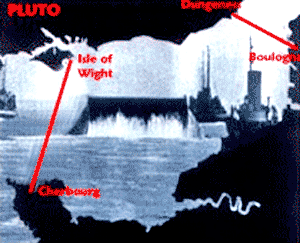
The pipeline had to be of small diameter, to
keep size and weight manageable.
Hartley remembered that a difficult pumping
problem in Iran’s hills had been solved using a three-inch diameter pipe
carrying fluid at 1,500 psi, which brought 100,000 gallons per day 40 miles
between pumping stations.
Finally, under Hartley’s direction, the British
company Siemens developed the Hais (short for Hartley-Anglo-Iranian-Siemens)
cable: a lead pipe swathed in insulation, reinforced by steel wire, and
coated in tar and yarn. Before the war was over, several pipelines were laid
across the English Channel, pumping a combined total of 1.35 million gallons
per day.
Though little known to members of the public, “Pluto” played a
critical part in oiling the Allied war machine in western Europe.
Continuous pipe technology has come a very long way since World War II, so
the pipe ordered by the Israelis is quite different to that used by the
Allies. Remember also that there is no requirement for sub sea work in the
eastern and western “extensions” of the Tapline. The Israeli pipe can be
laid straight onto the ground, supported where necessary by special air bags
originally designed for underwater work in the North Sea.
To generate the
required high pressure in the western pipeline, three prefabricated
diesel-powered pumping stations have been ordered, with a fourth as backup.
Planners are confident that pumping equipment for the eastern extension of
the Tapline can be “borrowed” or “requisitioned” from the Iraqis.
With Kuwait and Bahrain tacitly in tow, and the Saudis sidelined, the main
threats to Operation Shekhinah should theoretically be Jordan and Syria.
After all, this plan calls for a large chunk of Jordanian territory to be
“annexed”, a favorite Jewish pastime, but not one likely to meet with the
approval of the Jordanian people.
Obviously the main threat to Israel on
Jordanian territory will come from the Jordanian military, which has been
given some very strange orders these past few months after spending decades
fiercely guarding its border with Israel. King Abdullah has now quietly
confirmed he no longer regards Israel as a threat, and is ordering major
units of the Jordanian Army to relocate south, in order to face possible
threats from the largely fictional “Al Qaeda Network”.
Though no details are to hand, it is understood that a secret meeting has
already taken place between Israeli and Jordanian government officials,
intended to discreetly force King Abdullah’s hand in return for a
“consideration”, namely oil. He may have little choice in the matter. Jordan
is an exceedingly poor country with about $6 billion in external debt, and
about half a million Palestinian refugees to care for.
Until 1990 Saudi
Arabia provided “grace and favor” oil to Jordan along the Aramco Tapline,
but swiftly shut down the pumps in 1991 when King Hussein voiced support for
President Hussein of Iraq. They were never turned back on.
After the Gulf War, Iraq started supplying Jordan with its critical oil, but
what will happen post-Shekhinah when Israel has control of southern Iraq? It
is understood that Israel has offered to continue Jordan’s oil supply
provided it agrees not to “interfere” with Israeli operations in the north
of the country. Because of recent inexplicable Jordanian military movements
to the south, this information is considered reliable.
Syria will not be so easy to hold in check, because it has a history of
fighting Israel at every twist and turn, and furthermore has a border in
close proximity to the “hijacked” western end of the Tapline. To beef up
this particular border and minimize the risk, Israel intends to extend some
existing border minefields far to the east, in a bid to keep out the Syrian
armor.
Beyond that, Israeli air superiority will have to suffice.
It should be noted very carefully though, that in every sense Syria is the
wild card in the pack. If Israel seriously underestimates Syrian military
equipment, skill and determination, that country can and will terminate not
only Operation Shekhinah, but also the Jewish State. The same will apply if
Israel sends too large an occupation force to southern Iraq, thereby leaving
itself wide open to an attack on what it fondly regards as its “Home Land”,
i.e. Palestine.
Saudi Arabia, the unwitting and unwilling host to Operation Shekhinah, is
steadily being publicly and very deliberately undermined. By the time the
Israeli strike aircraft hit their first targets in southern Iraq, Saudi
Arabia will be so frightened of losing control of all its oilfields, no
defensive action will be taken in the north of the country.
The discreet
threats always use the fictional Saudi “Al Qaeda” connection as an excuse,
illustrated in this instance by the Wall Street Journal, the most powerful
newspaper in New York, and possibly the world.
On Friday 4 January 2002, Ralph Peters wrote:
“Since Sept. 11, the Saudis have mounted a
well-funded campaign to convince Americans that they bear no blame for
anything. But they're worried. It long has been a Saudi assumption that
they could buy whatever influence they needed in America, and they have,
indeed, had many an influential American on their payroll, from lawyers
and lobbyists to businessmen and out-of-work politicians. They joke
about us as they would about prostitutes, and regard us as no better, if
more enduringly useful. Their strategy worked as long as the rest of
America slept. But the Saudis learned, after the attacks on New York and
Washington, that the American people as a whole cannot be bought. Not
even with cheap oil.
“The same voices that cautioned us to do
nothing meaningful against terrorism now warn that any alternative to
the current Saudi regime might be even worse. That is a coward's
argument. The Saudi cancer will continue to metastasize if we shy away
from treating it, and any new government on the Arabian peninsula is
likelier to be scrutinized and contained than the checkbook terrorists
of the royal family. Why not give change a chance, instead of supporting
the most repressive and vicious monarchy remaining on this earth?
“We must begin by confronting the Saudis and
giving them the clear choice President Bush offered the rest of the
world: Either you are with us in the fight against terror, or you are
against us. There can be no middle ground--especially not for
terrorism's most enduring sponsors. We must work against the Saudis'
campaign of religious hatred and subversion around the world. And we
must begin looking for other regional partners, from a liberated Iraq to
a future Iran.
“Finally, we must be prepared to seize the
Saudi oil fields and administer them for the greater good. Imagine if,
instead of funding corruption and intolerance, those oil revenues built
clinics, secular schools and sewage systems throughout the Middle East.
Far from being indispensable to our security, the Saudis are a greater
menace to it than any other state, including China.
“Terrorism is not going to disappear, no
matter how successful our military, diplomatic and economic efforts.
Those efforts can, however, greatly reduce the appeal of terrorism to
prospective acolytes and diminish dramatically its power and reach,
while denying hard-core terrorists safe havens. Our efforts are off to a
superb beginning, and there is much reason for optimism, so long as the
strength of will of this and future administrations does not waver. ...
“
End quote
Part 2
17 April 2003 - 20 October 2003
from
Vialls Website
recovered through
WayBackMachine website
On 21 March 2003, the British
and Australian Special Air Services Regiments [SAS]
were unwittingly tasked with
protecting “Israeli Assets” H2 and H3 in Iraq’s Western Desert.
Their British and Australian
political masters stood these elite troops into clear and present danger,
without ever explaining the
real reason for their presence.
When Part One of Operation Shekhinah (above) was first published in January 2002, it
was viewed by many as a work of complete fiction.
“Where is the proof,” my
mainly Jewish critics asked, “that Israel intends to illegally invade Iraq
and steal its strategic oil reserves?”
At the time, I asked everyone to examine the evidence and reach their own
conclusions, because I was not yet ready to divulge the fact that this
critical intelligence was sourced directly from the offices of Israeli Prime
Minister Ariel Sharon. I had every intention of living long enough to write
this sequel, an ambition that may have been thwarted by Israel if I had
revealed my source at that early stage.
Those readers wishing to review part one should click on the links at the
top or bottom of this page, but in summary, the March 2001 Israeli
operational planning envisaged a lightning strike on southern Iraq, followed
by captured oil supplies being back-flowed to Haifa via the existing Trans
Arabian Pipeline [Tapline].
Possible protests by the “International Community” about the Blitzkrieg were
to be stifled by the Zionist-controlled media in New York and Washington,
DC, who would explain patiently that this was merely a surgical strike
against the “Evil Tyrant Saddam Hussein”.
Shekhinah planning accelerated through the northern summer of 2001, with a
firm invasion date set for 2 October 2001, the first day of a seven-day
Jewish holiday, and thus a most unlikely time to expect an Israeli attack.
Then, as if from nowhere, the Zionist-banking center in New York was razed
to the ground on 11 September 2001.
At a single stroke, the World Trade Center attack removed Shekhinah’s
reserve funding and its critical equipment supply from America, including a
large number of F15 Strike Eagle ground attack aircraft, instantly
relegating the premeditated Israeli invasion of Iraq to the back burner.
Thwarted in this first attempt to expand their territory to a “Greater
Israel” stretching east to the Iranian border, the Zionists were forced to
find another way of gaining control of Iraq’s oil reserves. So in early
April 2002,
George W. Bush was programmed to start attacking the “Evil
Tyrant Saddam Hussein” and his fictional “Weapons of Mass Destruction” on
television.
With the Israeli-Jewish lobby pressing all the right buttons,
George Dubya
completely redefined the term “megalomania’, occasionally dribbling spittle
down his shirt front as he made countless speeches aimed at directing hatred
towards the Iraqi President.
Without their knowledge or consent, American and other “Coalition” troops,
and countless Iraqi citizens were about to be sacrificed on the high altar
of Zion. As the fresh-faced youngsters took up their positions for the fight
ahead, most did so believing that this was a heroic western effort to rid
the world of “Weapons of Mass Destruction”, while a cynical minority nodded
sagely, muttering under their breath that America really wanted to steal
Iraq’s oil reserves.
As this report proves with hard evidence, both claims are completely false.
On the weapons side, UN Chief Inspector Hans Blix had already made it very
clear to the Security Council that, in his view, Iraq no longer possessed
any long range Scud missiles, nor any viable chemical or biological weapons.
By the time American-British-Australian invasion forces had cluster-bombed
their way to the Iraqi capital of Baghdad, this first reality had become
became self-evident.
Though defensive chemical warfare suits and atropine antidotes were found in
plenty, clearly positioned to protect Iraqi troops from an [expected]
American VX nerve gas attack, there were no Iraqi “Weapons of Mass
Destruction” to be found.
That leaves American domination and theft of Iraqi oil, right? No, it does
not.
The American and British oil multinationals already have enough oil and
gas reserves for their needs in various countries around the world, without
taking on a hostile country recognized in oilfield geopolitical terms as a
Russian client. Oil is a strategic military asset, and the American oil
multinationals knew then, and they still know now, that taking this insane
Iraqi road could easily lead to World War III.
Forget any and all television ramblings by “Texan Oilman” George Bush,
who
would have trouble distinguishing between an oil wellhead and a retail gas
pump. Like most politicians, George has grabbed seats on the boards of a
couple of minor oil companies for the cash benefits, but that is all. The
problem for George, is that he has so far failed to provide a valid American
motive for Operation Iraqi Freedom.
All crimes including the illegal invasion of a sovereign nation like Iraq,
require opportunity, motive and method. Any policeman on the street will
happily confirm this. Out of these three criteria, motive is by far the most
important, for without it the crime would not be committed in the first
place. A drug addict is motivated to steal by an uncontrollable need for
narcotics, and a car thief is motivated to steal by the need to convert
identifiable goods into anonymous cash.
The Israeli-Jewish lobby’s motive for the original Operation Shekhinah, and
latterly for Operation Iraqi Freedom, was and is based on the certainty that
the American economy and social structure is in steep decline. Unless the
Israel-Jewish lobby could somehow find a massive independent income stream,
the parasitic Jewish State would completely collapse in less than a decade.
We will examine this harsh reality later in the report.
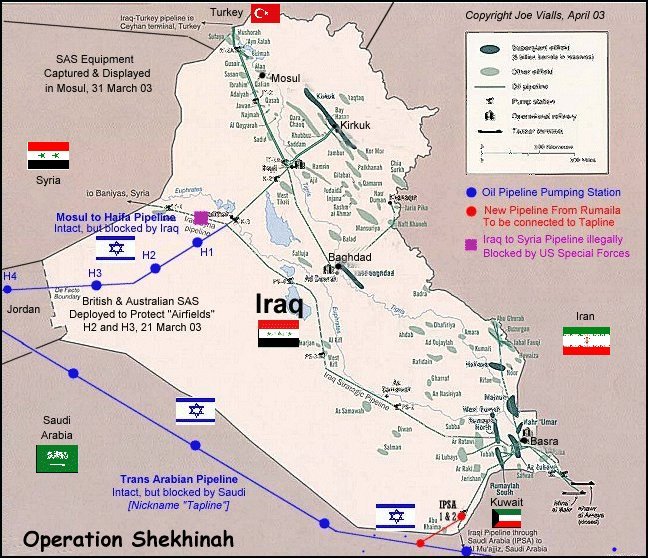
On the first day of Operation Iraqi Freedom, the British and Australian SAS,
in the company of unspecified American special forces, were deployed to the
Western Desert of Iraq in order to “protect” two strategic “airfields”
code-named H2 and H3, which “might” be used to fire Scud missiles at Israel.
This despite the fact that everyone from the UN Secretary General down to
the most humble of weapons inspectors, knew the claim was pathetic rubbish.
The last of Iraq’s scuds were destroyed many years ago.
What you were told quite clearly by the media, however, is that these highly
trained specialist troops, normally reserved for strategic reconnaisance
ahead of the main military force, had mysteriously been assigned to the mere
“sideshow” of protecting the Jewish State.
In Australia, this startling announcement was promptly followed by visits
and telephone calls from former Israeli Prime Minister Barak, and current
Prime Minister Sharon, publicly heaping lavish praise on Australian Prime
Minister John Howard, for protecting Israel against Scud missiles, which
Israel itself already knew no longer existed. So exactly what were these two
Prime Ministers thanking Australia for?
The short answer is that “airfields” H2 and H3 are actually “Haifa 2” and
“Haifa 3”, critical pumping stations on the oil pipeline that originally ran
all the way from Mosul in the north of Iraq to Haifa in Palestine, and
pumped oil until 1948. During that year Palestine was invaded by the “Jewish
State”, at which time Iraq blocked the pipeline near its western end.
But
recent Israeli claims that this Mosul to Haifa pipeline is nowadays
“dilapidated”, “out of action” and “runs through Syria” are intentional
disinformation.
As you can see on the map above, the Mosul to Haifa pipeline runs all the
way down the Western Desert of Iraq, then crosses into Jordan rather than
Syria, continuing west to a point near Amman, just a few miles short of the
Israeli border. Until very recently, Iraq pumped free oil along this
pipeline to Jordan, as a way of saying thank you for Jordan’s support during
the 1990-1991 Gulf War. “Free” oil for Israel has thus always been
tantalizingly close, and is the sole reason for “Operation Iraqi Freedom”.
For unspecified reasons that are now becoming much clearer, Bush, Blair and
Howard demanded that the best special forces in the western world should
defend a line running from H3 in the south, to Mosul in the north. By an odd
coincidence perhaps, this is the exact route of “Israel’s” Mosul to Haifa
pipeline.
Proof that this initial Israeli objective of securing the pipeline
as far north as Mosul had been achieved, was inadvertently provided by
Jane’s Defence Weekly on 3 April 2003.
“The parading on Al Jazeera television of UK equipment in the northern Iraqi
city of Mosul on 31 March provided a brief glimpse into the SAS role in
toppling Saddam Hussein's regime. Footage showed Iraqi civilians jubilantly
driving a Land Rover through the streets of the city, then a quad-bike and a
collection of weapons being displayed at an Iraqi military base.
“This included hand-held rocket launchers, 40mm grenades, machine guns and
specialized radio equipment, suggesting this was not from an conventional
British Army unit. The location of the incident, far from the main UK
operating area around Kuwait and Basra, immediately led to media speculation
that the highly secretive 22nd SAS Regiment was in some way involved.”
According to Russian Military Intelligence [GRU] reports, this was indeed
the case. In a chilling report released on 2 April, twenty-four hours before
Jane’s wrote about the Land Rover, quad-bike and other special forces
equipment in Mosul, the GRU stated:
“Tactical attack units from the American 82nd Airborne Division and the 22nd
SAS Regiment, earlier deployed to northern Iraq near the town of Al-Buadj,
were destroyed and dispersed as the result of a daylong battle with the
Iraqi troops. The exact number of [coalition] losses is still being
verified.
“Intercepted radio communications show that the coalition troops are
retreating in small groups and have no exact information about their own
losses. Currently the remaining units are trying to reach the
Kurdish-controlled territory. It is believed that up to 30 [coalition]
soldiers were killed or captured by the Iraqis.”
The Mosul to Haifa pipeline is a “bonus” not originally envisioned under the
original 2001 Operation Shekhinah, which called only for the capture of
southern Iraq and the old Trans Arabian Pipeline, which runs east to west
along the extreme northern edge of Saudi Arabia [see
above map].
The original 2001 Operation Shekhinah was a “can do” solo Israeli objective,
bearing in mind the sheer distance over flat desert separating Baghdad from
Basrah, and Israel’s overwhelming air superiority. If the Iraqi Republican
Guard moved south over the desert in an attempt to intervene, they would be
swiftly decimated by state-of-the-art Israeli aircraft, all provided free of
charge by generous American taxpayers.
With the rich Mosul to Haifa pipeline now added to the war booty, predicted
profits have already gone through the roof, with Israeli traders excitedly
muttering to each other about “New Rotterdam” becoming the jewel in the
Israeli-Jewish crown. At a more subtle level, the hijacked oil supplies are
intended to help fund the planned expansion of the Jewish State, east to the
Iranian border.
Nowadays, visible Israeli-Jewish greed for free Iraqi oil borders on the
obscene. Less than a week ago while body bags containing dead Americans and
Britons were still piling up in Kuwait refrigerated storage [believe me, you
really don’t want to know how many], Israeli-Jews were already starting to
gloat publicly about their future oil wealth.
A leading Tel Aviv newspaper
explained:
“Israel's National Infrastructures Minister Yoseph Paritzky is already
meeting with Jordanian officials about the [Mosul-Haifa] pipeline, on the
assumption that a pro-Western government will be set up following the US-led
war.
“Minister Paritzky reportedly believes that restarting the pipeline could
reduce Israel's fuel costs by 25 percent and turn Haifa into "the Rotterdam
of the Middle East" - a major oil export terminal. UPI quotes international
relations researcher Dr. Hooman Peimani of Geneva as saying that the venture
will reduce Israel's dependence on Russian crude and the cost of its energy
imports.”
What the newspaper failed to report, was that on the very same day Israeli
Prime Minister Ariel Sharon called American Secretary of State Colin Powell,
instructing him to start pumping oil as quickly as possible.
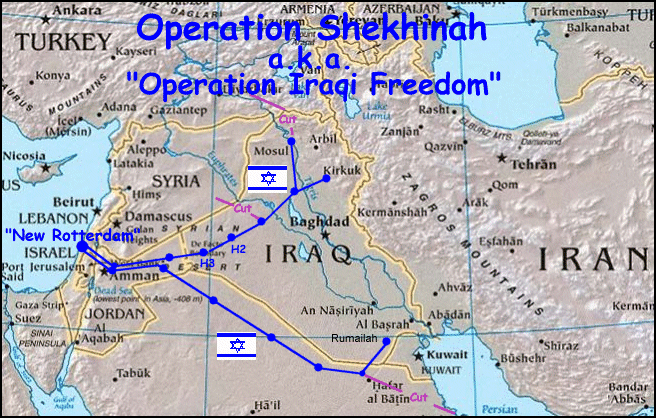
Evidently,
indicted war criminal Ariel Sharon wished to make it crystal clear exactly
who was really in control of American foreign policy, and in charge of US
military assets.
Before examining exactly how the “New Rotterdam” expects to operate, we
should first answer the obvious question of "Why bother with Operation Shekhinah at all?"
It is an open secret that when the powerful
Israeli-Jewish lobby snaps its fingers in New York, American taxpayer cash
and defense equipment is immediately provided by the shipload. Which of
course brings us right back to the failing American economy and social
structures mentioned earlier in this report.
Since early 2000, it has been obvious to most informed analysts that
America’s economy and employment have been in ever-decreasing decline, made
worse by several nations switching their oil trading from US Dollars to
Euros. If the situation worsens, perhaps triggered by OPEC switching all oil
trade to Euros, with China and Japan panicked into converting their own
massive holdings to Euros, the United States Dollar will crash completely,
driving America into a depression of hitherto unimaginable severity.
The Jewish State is a true parasite, wholly dependent on massive American
funding in order to survive. Remove that funding either intentionally or
accidentally, and the Jewish State would be overrun and destroyed in a
matter of months. Though the entire Middle East now hates America with a
passion, it reserves its deepest loathing for the Jewish invaders, who,
every single day without end, bring more death and destruction to the
helpless women and children of Palestine.
So what is a poor parasite to do, when its host appears to be running out of
the fiscal nourishment it depends on for its very survival? Most normal
parasites would seek out a new host, but this is an impossible task for the
Jewish State. There is simply no other country on earth capable of
generating sufficient revenue to cope with the greed and corruption in Tel
Aviv.
The only answer of course was Operation Shekhinah “mark two”, renamed
Operation Iraqi Freedom and designed to provide the Jewish State with
massive income streams from stolen Iraqi oil. The prime objectives were to
decapitate [murder] President Saddam Hussein, decimate the Iraqi military
structure, and destabilize the country completely.
After that, a carefully
selected “Military Governor” would be installed, followed by a carefully
selected “Interim Administrator”, both of whom could be relied on to look
after Israel’s best interests, rather than those of America. The
Israeli-Jewish lobby in New York vetted a few possible candidates, then made
their final choices.
The new “Military Governor” of Iraq will be retired American Lieutenant
General Jay Garner, a very close and ardent supporter of Israel. In fact,
Garner is a member of the Jewish Institute for National Security Affairs (JINSA),
a cabal of Jewish American military officers who have long advocated putting
Israel's security needs before those of the United States.
From Israel’s
viewpoint, Garner is their perfect point man in Iraq, guaranteed to solve
any little “problems” that might be encountered while setting up the two
massive oil pipelines running from Iraq to Haifa.
Following in Jay Garner’s footsteps will be new “Interim Administrator”
Ahmad Chalabi, who was convicted in Jordan in 1992 of 31 charges of
embezzlement and misuse of funds while running the Petra Bank, a known
Mossad front. Chalabi was sentenced to 22 years imprisonment, but somehow
managed to “escape” from police custody in Amman before he could be
transported to prison.
With a Mossad man in place and ready to select the final “democratic”
Government of Iraq, Israel predictably feels very confident that any and all
other little problems with oil supplies for New Rotterdam can be swiftly
resolved, either with a few shekels or with a bullet.
Iraq was [apparently] already conquered by coalition forces and [apparently]
under western control, so the impatient Israeli-Jewish lobby immediately
pointed George W. Bush and Co. at Syria, which, as I noted back in January
2002, is the wild card in the Shekhinah pack, because of its close proximity
to the massive oil pipelines running along its southern border, from Iraq to
the New Rotterdam at Haifa:
“It should be noted very carefully though, that in every sense Syria is the
wild card in the pack. If Israel seriously underestimates Syrian military
equipment, skill and determination, that country can and will terminate not
only Operation Shekhinah, but also the Jewish State. The same will apply if
Israel sends too large an occupation force to southern Iraq, thereby leaving
itself wide open to an attack on what it fondly regards as its ‘Home Land’,
i.e. Palestine.”
Obviously I wrote this paragraph many months before the Israeli-Jewish lobby
managed to suborn the entire US Military for a massive attack across the
length and breadth of Iraq. This changed things considerably in the planning
phase, with Israel now intent on using American firepower to eliminate the
Syrian risk completely
After the Bush-Rumsfeld-Powell choir launched the catchy new “Syria is
Harboring Weapons of Mass Destruction” jingle on 14 April, Powell gave a
speech to the Israeli-Jewish lobby
AIPAC [American Israel Public Affairs
Committee], confirming that the US will not stop with Iraq:
"Syria can continue direct support for terrorist groups and the dying regime
of Saddam Hussein, or it can embark on a different and more hopeful course.
Either way, Syria bears the responsibility for its choices -- and for the
consequences." [Wild applause and hooting from the audience, largely
composed of powerful and well-connected establishment Jews.]
The word “consequences” has only one meaning in the
megalomaniac worlds of
the US State Department and the Israeli-Jewish lobby.
Syria must immediately
agree to replace President Bashar al-Assad with Ahmad Chalabi’s younger
brother, or be bombed back into the Stone Age.
Theoretically then, only a few thousand more American cluster bombs on
Damascus lie between Israel and its staggering quantities of black gold
flowing through New Rotterdam, made possible solely by Coalition firepower
and Coalition lives.
Israeli-Jews will be able to strut their stuff on the
streets of Tel Aviv, as tons of freshly minted Shekels cascade all over the
entire city.
To hell with America!
In reality, things are set to be a whole lot more difficult than that. The
academic Israeli-Jewish lobby planners in New York were living in a dream
world where nothing could go wrong, and who in turn were advised by
resplendent retired generals in business suits. The closest any of these
jokers ever got to real combat, was driving a Jeep around the Pentagon car
park on Halloween.
As Jay Garner and Ahmad Chalabi hide nervously behind bodyguards in southern
Iraq, they know that things are not what they were planned to be.
Peter
Arnett and Robert Fisk have already confirmed that Saddam Hussein was not
decapitated in the bunker-buster attack, meaning that he, his two sons and
the Iraqi Command Council are still out there somewhere.
Military counts have confirmed that very few Republican Guardsmen were
killed in the coalition attacks, in turn meaning that somewhere in Iraq
there are 300,000 trained soldiers with at least one rifle each. All are now
in civilian clothes, and all hate America and Israel with a passion
bordering on fanaticism. Very likely arranged in small cells of four to six
men, these soldiers will probably wait until sheer cost forces America to
remove much of its heavy armor from the country.
After that, Iraq will probably resemble Northern Ireland at the height of
IRA power, but on a much larger scale. If you can imagine a Northern Ireland
nearly twice the size of Vietnam, containing 299,900 more trained shooters
than the IRA, you will probably be close to the reality of Iraq after most
of the coalition invaders withdraw to the south.
Then there is the small problem of sorting out the vast oilfields and
pumping crude to Israel, the main objective of “Operation Iraqi Freedom”.
Speaking as a former oilfield troubleshooter, I can assure you this will be
an impossible task if the Iraqis wish to block it. There are a thousand ways
to sabotage the operation, not the least of which is picking off the workers
with sniper rifles. Sooner or later, no one will want to go to work at all.
Externally, Russia might be a problem, though Vladimir Putin has assured the
world that the nine Russian warships and three nuclear submarines currently
on their way to the northern Indian Ocean, “will only be engaging in
exercises with the Indian Navy”. Thank heavens for that, because the Russian
fleet is packing enough nuclear punch to completely wipe out Saudi Arabia,
or the eastern seaboard of America!
History has taught us however, that the poker-faced “Black-Belt Vlad” [only
to personal friends at his Dojo], can sometimes be rather economical with
the truth, making it essential to listen to retired admirals in Moscow if
you want to get the whole picture.
Two weeks ago, one of these admirals commented,
“It is interesting that a
very large amphibious assault ship with commandos and tanks on board, has
been included in the fleet.”
When he was predictably asked what sort of
target the assault ship might be used against, the Admiral replied,
“Oh, for
attacking and capturing a small port, perhaps the size of Umm Qasr or Basrah.”
During 1933, famous author H. G. Wells wrote a book called
The Shape of Things to Come, in which he accurately forecast that World War II would
start, “out of a conflict between Germany and Poland circa 1939”.
In the
same book, Wells also wrote that World War III was to commence, “from some
future [unidentified] event in Basrah, Iraq.”
Update, 19 April 2003
Israel Officially Approaches Turkish Labor For Help Stealing Iraqi Oil
At 16:36 local time on 17 April in Istanbul, Turkey, less than 24 hours
after this Operation Shekhinah report was first linked on the Internet, it
was reported that Israel has already approached Turkish contracting firms to
re-activate the Mosul to Haifa Pipeline.
This report from
www.turks.us:
“Israel has made an offer to Turkish contacting firms to reactivate the
Mosul-Haifa pipeline, which has been closed for the last 55 years. Not only
the Israeli government but also Israeli firms have reportedly approached
Turkish companies for an oil pipeline that would provide transportation of 5
million barrels of oil from northern Iraq to the Israeli port of Haifa.
“Turkish Contractors Union Chairman Nihat Ozdemir confirmed the offers from
Israel and noted that a considerable part of the Baku-Tbilisi-Ceyhan oil
pipeline construction had been carried out by Turkish firms. Pointing out
that Turkish construction firms had important experience in the subject of
international oil transportation, Ozdemir said that it was ‘normal’ that
Turkish firms had been chosen to rebuild the pipeline.”
For those readers puzzled by what at first appears to be a ‘one-time-only’
transportation of 5 million barrels of oil, is it pointed out that oil
pipeline contracts are quoted in barrels per day [bbpd] continuous flow.
This means that the Israeli-Jews have indirectly advised us though Turkey,
that they are already planning to steal 1,825 million barrels of Iraqi oil
per annum.
Taking a nominal price of US$25.00 per barrel FOB “New Rotterdam” [after the
deduction of engineering expenses and bribes], the Israeli-Jewish terrorists
stand to make a cool US$ 45,625,000,000.00 each year over the bodies of
thousands of dead Iraqi, American and British soldiers, deliberately
sacrificed in the deserts and cities of Iraq for the “Greater Good of
Israel”.
The fact that the Israeli-Jews will probably not be allowed to get
away with it, does nothing to diminish their despicable cold-blooded
planning and intent.
Turkish Foreign Minister Abdullah Gul is now aware of Israeli intent, and is
stated to be “very angry”, which may the diplomatic understatement of the
year. Since sanctions were imposed in Iraq after Gulf War I, Turkey has lost
at least US$6 billion in oil transit and handling fees, which has left
Turkey all but destitute. Thus Gul is unlikely to stand by and watch this
essential income stream destroyed forever by Tel Aviv.
Local media reports suggest that Turkey currently has around 60,000 troops
with a very large quantity of armor on the northern Iraqi border, which lies
within easy striking range of Mosul. The next few weeks and months might
turn out to be very interesting.
The prestigious “Jane’s Intelligence” organization in Britain has shown a
passing interest in this Israeli thirst for Iraqi oil, and has posted a
cautious analysis, which can be read
by clicking here.
Update, 22 April 2003
Bush Demands Iraqi Airfields to Protect “Israeli” Oil
US Marine tear down
statue of Saddam Hussein in Paradise Square, Baghdad, at 1130 hrs on 9 April
2003.
Four hours after
this American public relations spectacular,
the real Saddam Hussein
appears less than six miles north of Paradise Square,
mobbed by armed
supporters!
US Marine tear down statue of Saddam Hussein in Paradise Square, Baghdad, at
1130 hrs on 9 April 2003. Four hours after this American public relations
spectacular, the real Saddam Hussein appears less than six miles north of
Paradise Square, mobbed by armed supporters!
In a move once that once again reinforces the accuracy of the original
Operation Shekhinah intelligence,
George Dubya Bush has demanded four “key”
airfields for an ongoing “strategic alliance with the new Government of
Iraq.” To say this is premature would be seriously understating the case. As
of yesterday, American forces had actual physical control of less than
three-percent of sovereign Iraq.
For those who remember Vietnam, the pattern will seem disturbingly familiar:
America has now installed several small but heavily defended “Fire Bases”
across Iraq [including Paradise Square, Baghdad], and is using media
trickery to try to convince the public that these tiny fire bases represent
the complete conquest of Iraq.
The public certainly believed this pathetic
media rubbish about Vietnam, right up to the point where Americans were
finally and desperately evacuated from the roof of the US Embassy in
downtown Saigon.
Back then, the Vietcong and North Vietnamese Army controlled roughly 97% of
South Vietnam, i.e. all of the country except the tiny American fire
bases, plus three heavily defended airfields and a few brothels in Saigon.
One way and another, this led to 50,000 Americans being repatriated to the
United States in body bags.
Today, the Iraqi Republican Guard and Home Guard
Units control roughly 97% of greater Iraq, and the serious killing will
probably commence when temperatures exceed 50°C, just a few weeks from now.
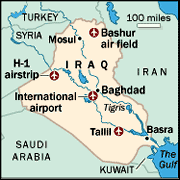
The actual positions of Dubya’s four new “key” bases shown on the map above
are critical.
The New York Times reports,
“One will be at the international
airport just outside Baghdad, according to Bush administration officials,
while the others will be at Tallil, near An Nasiriyah in the south; at an
isolated airstrip called H-1 in the western desert, along an old oil
pipeline that runs to Jordan; and at the Bashur air field in the Kurdish
north”
Extraordinary!
H1 [Pumping Station Haifa 1] has at last been mentioned
officially, obliging the Israeli-Jews to upgrade last month’s very
deceptive,
“old Haifa-Mosul pipeline that once used to run through Syria” to
the somewhat more accurate “old [operational] oil pipeline that runs to
Jordan”.
Even a cursory glance at the large maps above shows how strategic these
bases are, specifically in terms of protecting the massive Israeli-Jewish
theft of Iraqi oil to Haifa, the “New Rotterdam”. The H1 you were never told
about before, is located just south of the pipeline manifold where American
forces recently cut the flow of oil from Iraq to Syria.
This airfield will be used to effectively “control” Eastern Syria. Bashur in
the north will be used to crush any Kurdish dissent, while Tallil will guard
the old Tapline from Saudi Arabia. Well, theoretically at least. Before
using H1, the Americans will have to do a lot of hard work laying and
extending the runways.
At present, the rough airstrip at H1 is suitable only
for light aircraft servicing the pipeline pumping station. ,
"There will be some kind of a long-term defense relationship with a new
Iraq, similar to Afghanistan," said one senior American administration
official.
Yeah, right!
Nowadays Afghan puppet president Hamid Karzai, who
was installed by New York to protect the CIA’s heroin trade from Afghanistan
through to the Golden Triangle, is completely surrounded by angry Afghan
warlords, who kill American soldiers whenever and wherever they want to. A
true though disturbing sign of things to come in the new Israeli-Jewish
‘Democratic’ Iraq.
On a lighter note, it seems that US Central Command in Qatar lied to us
yesterday, which I feel sure will come as an enormous surprise to everyone!
Apparently in an attempt to deflect attention away from the very real Mosul
to Haifa pipeline that the SAS has been inadvertently protecting for Israel,
the PR folk hastily rushed out some really pretty pictures which, they
claimed, showed the SAS "guarding captured Iraqi aircraft at a secret
airfield west of Baghdad".
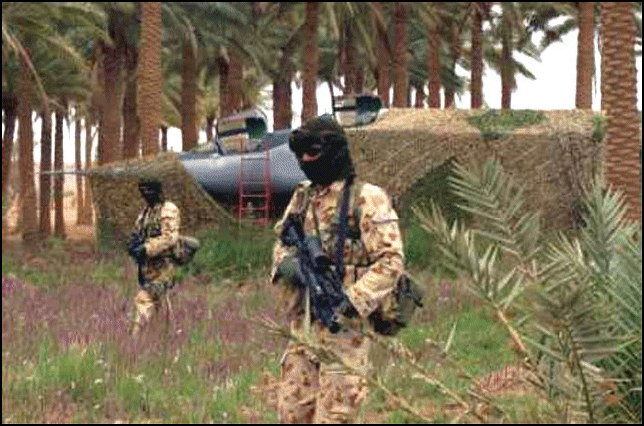
What these [unidentifiable] hooded men are guarding is a very rare Russian
aircraft known as the Mig 25-PU.
Known generically to the world as the Mig
25 "Foxbat", this version is a two-seat interceptor trainer produced in
numbers so small that every aviation buff in the world knows where they all
are. Iraq had never bought any Mig 25-PUs, has not borrowed or been given
any Mig 25-PUs, so this official picture from US Central Command cannot have
been shot in Iraq. It really is that simple...
The headgear worn by these heroes is mildly interesting, because it is very
similar if not identical to that worn by Russian special forces, normally
but not always in Russia. The colors on the aircraft indicate that is most
likely one belonging to Tajikistan, where certain units of the SAS [hush my
mouth...] went on exercise a year or two ago. Remember Exercise "Enduring
Freedom"?
Someone really should have a quiet word with US Central Command. If you know
their telephone number, call and tell them that if they really want to fool
the western public, their PR folk really should use a picture of an aircraft
that most people will actually believe is [or can be] in Iraq.
Try to stick
to the ubiquitous Mig 21.
Almost everyone in the Middle East has a few of
these, including Saddam...
Update, 06 May 2003
The London Observer "Outs" Israeli Plans to Steal Iraqi Oil
"Plans to build a pipeline to siphon oil from newly conquered Iraq to Israel
are being discussed between Washington, Tel Aviv and potential future
government figures in Baghdad. The plan envisages the reconstruction of an
old pipeline, inactive since the end of the British mandate in Palestine in
1948, when the flow from Iraq's northern oilfields to Palestine was
re-directed to Syria.
"Now, its resurrection would transform economic power in the region,
bringing revenue to the new US-dominated Iraq, cutting out Syria and solving
Israel's energy crisis at a stroke. It would also create an end less and
easily accessible source of cheap Iraqi oil for the US guaranteed by
reliable allies other than Saudi Arabia - a keystone of US foreign policy
for decades and especially since 11 September 2001.
"Until 1948, the pipeline ran from the Kurdish-controlled city of Mosul to
the Israeli port of Haifa, on its northern Mediterranean coast. The revival
of the pipeline was first discussed openly by the Israeli Minister for
National Infrastructures, Joseph Paritzky, according to the Israeli
newspaper Ha'aretz .
"The paper quotes Paritzky as saying that the pipeline would cut Israel's
energy bill drastically - probably by more than 25 per cent - since the
country is currently largely dependent on expensive imports from Russia. US
intelligence sources confirmed to The Observer that the project has been
discussed. One former senior CIA official said: 'It has long been a dream of
a powerful section of the people now driving this administration [of
President George W. Bush] and the war in Iraq to safeguard Israel's energy
supply as well as that of the United States.
'The Haifa pipeline was something that existed, was resurrected as a dream
and is now a viable project - albeit with a lot of building to do.' The
editor-in-chief of the Middle East Economic Review , Walid Khadduri, says in
the current issue of Jane's Foreign Report that 'there's not a metre of it
left, at least in Arab territory'.
"To resurrect the pipeline would need the backing of whatever government the
US is to put in place in Iraq, and has been discussed - according to Western
diplomatic sources - with the US-sponsored Iraqi National Congress and its
leader Ahmed Chalabi, the former banker favoured by the Pentagon for a
powerful role in the war's aftermath.
"Sources at the State Department said that concluding a peace treaty with
Israel is to be 'top of the agenda' for a new Iraqi government, and Chalabi
is known to have discussed Iraq's recognition of the state of Israel. The
pipeline would also require permission from Jordan. Paritzky's Ministry is
believed to have approached officials in Amman on 9 April this year. Sources
told Ha'aretz that the talks left Israel 'optimistic'.
"James Akins, a former US ambassador to the region and one of America's
leading Arabists, said: 'There would be a fee for transit rights through
Jordan, just as there would be fees for Israel from those using what would
be the Haifa terminal. 'After all, this is a new world order now. This is
what things look like particularly if we wipe out Syria. It just goes to
show that it is all about oil, for the United States and its ally.'
"Akins was ambassador to Saudi Arabia before he was fired after a series of
conflicts with then Secretary of State Henry Kissinger, father of the vision
to pipe oil west from Iraq. In 1975, Kissinger signed what forms the basis
for the Haifa project: a Memorandum of Understanding whereby the US would
guarantee Israel's oil reserves and energy supply in times of crisis.
"Kissinger was also master of the American plan in the mid-Eighties - when
Saddam Hussein was a key US ally - to run an oil pipeline from Iraq to Aqaba
in Jordan, opposite the Israeli port of Eilat. The plan was promoted by the
now Defence Secretary Donald Rumsfeld, and the pipeline was to be built by
the Bechtel company, which the Bush administration last week awarded a
multi-billion dollar contract for the reconstruction of Iraq.
"The memorandum has been quietly renewed every five years, with special
legislation attached whereby the US stocks a strategic oil reserve for
Israel even if it entailed domestic shortages - at a cost of $3 billion
(£1.9bn) in 2002 to US taxpayers. This bill would be slashed by a new
pipeline, which would have the added advantage of giving the US reliable
access to Gulf oil other than from Saudi Arabia."
For the Observer newspaper
click Here.
Though this Observer report is a reasonable summary of current events in
Iraq, and the advanced state of planning for Operation Shekhinah, it has
been somewhat misled by the apparent absence of the Haifa Pipeline in Jane's
Foreign Report, which apparently states, 'there's not a meter of it left, at
least in Arab territory'.
When it comes to pipelines of critical strategic value to Israel, map makers
and newspaper editors alike seem to to develop a rare form of collective
myopia. The Haifa pipeline still runs through Iraq and Jordan, is clearly
visible from any airliner, and remains fully operational with pumping
stations in place and well maintained.
So what about Israel's second route for stealing Iraqi crude oil, the old "Tapline"
running across the extreme northern edge of Saudi Arabia? What chance that
another branch of the myopic media might try to tell you 'there's not a
meter of it left, at least in Arab territory'?
Rest assured that if they do, they will be lying. The Trans Arabian
Pipeline, just like the Haifa Pipeline, is currently not pumping, but it is
full of oil, with pumping stations properly maintained. There is a slight
glitch, however.
According to reliable inside sources, the western oil
multinationals have refused to connect the pipelines or transfer Iraqi oil,
because there is no proper "sovereign title" to the product, and they are
not prepared to start World War III with Russia over the matter.
Update 20 October 2003
First Tacit American Admission of Defeat in Iraq
In the months following America’s illegal invasion of Iraq, it has become
increasingly obvious that the northern pipeline from Mosul, planned to be
reconnected to an export terminal in Haifa, is an impossible Zionist dream.
Whenever American troops approach the northern half of this particular
pipeline [see map at top of page], they are shot at and often killed by
Saddam Hussein’s Sunni counter-insurgency teams. Whenever American troops
approach the southern half of the same pipeline, they are shot at and often
killed by Muqtada Al-Sadr’s Shiite counter-insurgency teams.
While these attacks are actually taking place, additional Sunni and Shiite
counter-insurgency teams repeatedly blow up large sections of the main and
branch oil pipelines, making the movement of crude oil and refined product
impossible. Thousands of kilometers of oil pipeline are exposed above ground
level, which, as I accurately forecast before the invasion started, cannot
be defended by American troops.
All oil pipelines are pressurized, meaning that any Iraqi with a simple RPG
[Rocket Propelled Grenade] can shut down any part of any pipeline whenever
he wants, with a single shot. The last time I bothered to check, Iraq still
had more than 600,000 RPG rounds available, meaning that American troops can
go on getting killed and maimed for the next ten years, without any
significant oil flow from Iraq to Israel, or from Iraq to America.
Two weeks ago, in what may be the first tacit admission of defeat in
northern and central Iraq, America ordered its principal puppet in Baghdad,
Ahmed Chalabi, to approach Saudi Arabia with a plan to pump Iraqi crude
south-west through pipeline IPSA-1, for “onward transmission to the Red
Sea.”
In fact, IPSA-1 was Israel’s original choice for Operation Shekhinah in
March 2001, when the plan was for IPSC-2 and IPSC-1 to intersect the Trans
Arabian Pipeline [Tapline], for the onward transmission of stolen Iraqi oil
to the port of Haifa in Israel.
Understandably perhaps, the “Red Sea” was
not mentioned anywhere in the Shekhinah planning documents.
Though Chalabi’s approach came far too late in the day, it was without doubt
the only plan that had even a remote chance of success, which is why the
Israelis selected it months before their backers in Lower Manhattan were
suddenly razed to the ground on 11 September 2001.
As a quick glance at the maps on this page show very well, IPSC-2 and IPSC-1
start in the huge southern Rumaila Field, then closely hug the Kuwaiti
border before crossing the Neutral Zone into Saudi Arabia. When American
forces are finally compelled to leave northern and central Iraq and retreat
to the south, it is not difficult to see the logic of America’s latest
desperate tactical plan.
Though 150,000 American troops have absolutely no chance of defeating and
holding greater Iraq, there is no reason to believe they could not hold
defensive positions in the relatively small portion of Iraq to the south of
an east-west line drawn across the top of the Rumaila Field at Basra.
Theoretically, this would then give America absolute control of the massive
Rumaila Field, of the oil export terminals near Basra, and finally control
of land pipelines running south-west, which are well out of reach of Iraqi
Sunni & Shiite counter-insurgency teams.
Unfortunately for America, the Saudi Government knows only too well who
pulls George Bush’s puppet strings, and it also knows about Operation Shekhinah.
Al Jazeera reported on 20 October 2003 [link below] that
Chalabi’s approach was smoothly rebuffed by the Saudis, with an anonymous
Aramco official saying the Iraqis,
"don't know what they are talking about.
The pipeline is not in a stage to be utilized."
The Saudis know as well as I do that there is nothing wrong with either
IPSC-1 or IPSC-2, both of which remain full of oil [to exclude oxygen and
avoid corrosion], and could be put back into operation in less than three
months, as could the Tapline across to Jordan and then on to Israel.
Unfortunately for Chalabi and his bunch of cutthroats in Baghdad, the Saudis
kicked the Americans out of the Kingdom only last year, and very sensibly
refuse to let them back in.
Shipping substantial quantities of crude oil out of Iraq via the Persian
Gulf remains unthinkable, with significant dangers on the al Faw peninsula,
and also from Iran just a few kilometers away.
With the northern and western
pipelines to Turkey and Israel now in tatters, IPSC-1 is the sole remaining
route along which Israel and America can steal Iraqi crude oil, but they
have left it too late.
More Information










